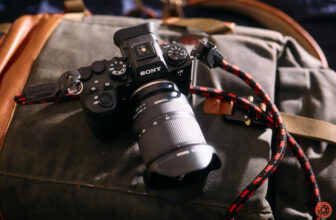
Check out our latest products
As AI is becoming more integrated into everyday life, you might wonder: What game-changing AI technology is in digital mirrorless cameras today?
The shift from film to digital—and later from DSLRs to mirrorless—transformed photography as we knew it. Now, AI is driving the next major disruption in camera technology.
With AI, we’re entering an era where the camera doesn’t just capture but thinks, predicts, and makes decisions in real time. And mirrorless systems are at the heart of this new transformation.
From AI-powered autofocus to in-camera upscaling and image enhancements, these are just the first steps in the next leap of cameras.
Let’s take a look at the new AI features in mirrorless camera systems.
Game-Changing AI Features in Mirrorless Cameras
AI has made its way into our cameras, and unlike most new tech that turns out to be hype, AI features deliver results.
These aren’t just ordinary incremental updates that make cameras slightly better. They’re changing how we shoot.
Let’s take a look at some common AI features in cameras.
AI-Powered Autofocus

Credit – Denise Jans
Remember the technique focus-and-recompose? It might become history soon.
That’s because the latest mirrorless cameras from top brands like Nikon, Canon, Sony, and Panasonic all come with AI autofocus systems that automatically track subjects and lock focus with super precision.
Sony leads the pack with its AI-powered real-time tracking and autofocus, which uses advanced algorithms for subject detection. It can seamlessly transition from objects to specific features like eyes and face, and keep the focus locked even if the subject leaves the frame briefly.
Similarly, Canon uses deep learning data that powers its autofocus system and allows it to recognize humans and animals with very high accuracy.
Nikon isn’t far behind—its autofocus system, powered by AI, can maintain focus even when a subject briefly moves behind an obstacle. For example, if a bird ducks behind a twig, the camera still keeps it locked in focus.
These advanced AI autofocus systems don’t just find focus; they predict movement. Your latest mirrorless camera can calculate where a racing car or flying bird will be, milliseconds before it gets there.
Eye and Face Detection
New mirrorless cameras have become great at finding and tracking human faces and eyes.
Even when someone turns their head or blinks, the camera maintains focus on the correct eye, usually the one closest to the camera.
Canon’s R-series cameras can track eyes even in challenging lighting. And Sony’s Real-time Eye AF works so well that it almost feels like the camera is in control.
Nikon’s Z-series cameras can even detect eyes through sunglasses or when partially obscured.
The real benefit is that you get perfect portrait focus each time. Your subjects can move naturally while the camera keeps their eyes tack sharp.
Sports Autofocus
Fast-moving action like sports has always been one of the biggest challenges for photographers, as it requires a robust autofocus system as well as skill.
But AI sports autofocus mode takes the game to a whole new level. It uses machine learning to reliably predict where the players are going to move, not just where they are right now.
Cameras like the Canon R3 and Sony a9 III work flawlessly when tracking fast-moving things like basketball players, tennis balls, or hockey pucks.
These systems actually learn the difference between how a soccer player moves versus a gymnast and understand that different sports have completely different movement patterns.
In simple words, it means the camera can think ahead of the action, which means you’ll miss way fewer of those split-second moments because the focus system is already two steps ahead of what’s happening.
Subject Detection: Animals and Humans


Credit- Jaya. K Surya
Modern mirrorless cameras don’t just see, they understand what they’re looking at.
The latest models from Sony, Canon, and Nikon distinguish between people, dogs, cats, birds, and even vehicles with remarkable consistency.
Fujifilm’s X-H2S recognizes motorcycles, birds, and even drones distinctly.
Sony’s latest top-of-the-line cameras can track wildlife and even insects with their Insect Eye AF.
This isn’t a simple face detection but a fundamental shift in how cameras interpret scenes and subjects.
What makes this a big deal is the remarkable consistency.
When shooting fast-moving subjects in challenging conditions, your hit rate jumps dramatically because the camera understands the difference between your subject’s face and the tree branch that’s blocking it.
Scene Recognition
Your mirrorless camera is now capable of looking at a scene and thinking: “Backlit portrait at sunset” or “Fast-moving sports under fluorescent lights” and then adjusting settings accordingly.
Fujifilm’s latest models, like the X-T5, recognize over 20 distinct scenes, while Canon optimizes exposure and color based on complex scene analysis.
It’s like having an assistant constantly adjusting settings behind the scenes.
This isn’t just auto mode with a new name; rather, it’s contextual awareness that delivers consistently better results in difficult lighting situations without making you adjust the settings too much.
AI Image Processors


Credit – Igor Omilaev
All this smart stuff needs serious computing power, and that’s where dedicated AI processors come in. Sony’s latest mirrorless cameras have a separate AI Processing Unit just for visual recognition, while Canon builds AI processing into their DIGIC chips.
These aren’t just faster regular processors. They’re built specifically for visual analysis and prediction without making your camera sluggish. It’s your camera’s second brain that’s watching and analyzing images and scenes while the main processor handles the camera operations.
You’d expect all the AI processing to slow down your camera or drain the battery, but these processors deliver instant subject recognition with minimal impact on speed or power.
AI-Powered Noise Reduction
Built-in noise reduction in previous generation cameras was pretty brutal as it got rid of noise, but often took important details with it.
Here, AI noise reduction is way smarter as it can tell the difference between actual image details like hair texture and unwanted sensor noise.
Sony’s real-time processing keeps fine details even when you’re shooting in ridiculously low light, whereas Canon’s system adapts to different types of noise depending on your shooting situation.
The tech actually looks at what’s in your image and only cleans up the bad stuff while leaving the details you want.
For anyone who shoots in challenging light, this means you can actually use those crazy high ISOs without your photos looking like a mess.
Thanks to AI noise reduction, your images will keep their natural texture instead of getting that over-processed look.
AI Stabilization
Image stabilization has evolved from simple shake correction to predictive systems that anticipate movement. For example, OM System cameras analyze hand tremor patterns to counteract them before they affect your image, giving you blur-free shots at slower shutter speeds.
Sony and Nikon use AI to distinguish between intentional panning and accidental movement, applying appropriate correction to each.
This means the need to turn off stabilization for some types of photography is vanishing as your camera now knows what you’re trying to do.
Other camera manufacturers like Fujifilm, Sony, Panasonic, etc. have also implemented AI into their stabilization modules.
Image Enhancements


Credit – Joseph Recca
One of the most useful developments in camera tech is that AI can enhance your images in-camera, making them ready to share on social media.
It includes intelligent sharpening that understands image content, selective contrast adjustment based on scene analysis, and color enhancements that adapt to lighting conditions in your photo.
Some cameras apply these enhancements in real-time during capture, while others offer AI-powered in-camera editing options.
Canon’s latest camera models can automatically enhance portraits by recognizing skin tones.
Apart from this, Sony offers AI-powered background blur that allows you to recreate the bokeh often found in fast portrait lenses.
However, the goal here isn’t to replace your editing workflow but to give you better starting points that require less post-processing and easy shareability.
Computational Photography
Computational photography is where software meets hardware to create images that go beyond what a single exposure can achieve.
Instead of capturing one photo, computational photography uses algorithms to combine multiple exposures, analyze scenes, and enhance images in ways that push past sensor limitations.
Think of it as your camera becoming a computer that processes multiple pieces of visual data to create one final image and produce results that would be impossible with a single click.
For example, OM System cameras like the OM-1 can produce handheld 50MP images from a 20MP sensor using sensor-shift technology and in-body stabilization to align multiple frames—no tripod needed. However, this relies on precision hardware and advanced algorithms rather than true AI.
Panasonic offers computational ND filters to simulate long exposures without attaching glass filters. Also, some of their cameras allow the creation of 187 megapixel images by combining eight sensor-shifted shots.
Canon R5 and R6 offer Smart HDR that analyzes scenes and uses selective tone mapping. Likewise, Fujifilm’s X-T5 offers Dynamic Range Priority, which intelligently blends exposures to protect highlights and shadows.
Finally, AI is starting to shine in noise reduction. Many modern cameras use AI-trained models to differentiate between fine subject details, like eyelashes, and random sensor noise, preserving sharpness while smoothing grain.
Computational photography isn’t just limited to these features but also plays a key role behind the scenes in burst mode, color enhancement, and image stabilization.
AI-Enhanced Video


Credit – Sharegrid
Video shooters are experiencing the biggest AI revolution. Sony’s ZV cameras automatically reframe subjects for social media formats, while Canon R-series cameras predict subject movement for smooth focus pulls that previously required a dedicated focus puller.
Additionally, there’s AI stabilization that figures out the difference between intentional camera movements and hand shake, meaning your shaky footage can potentially look gimbal-smooth without the extra gear.
For solo content creators, this means professional-looking results without a crew as your camera can operate itself and do things like focus pulling, and also act like a stabilization rig.
Voice & Gesture Control
Thanks to AI, now there are better and easier ways to interact with your camera.
For example, Sony’s vlogging cameras respond to voice commands even in noisy environments, and their gesture recognition lets you trigger the shutter with hand movements.
This is great for solo shooters and vloggers, as they can change settings mid-recording without touching the camera or messing with tiny buttons while wearing gloves.
However, these features are not very common yet in stills-focused cameras, but most likely will get there soon.
AI Workflow Integration
The intelligence doesn’t stop at capture. AI can now tag and categorize your images based on content, faces, and quality.
Sony and Nikon cameras can flag technical issues like missed focus and also suggest crops based on visual composition.
For professional photographers who deal with thousands of images from a shoot, this pre-sorting saves hours in post-production.
This means your camera can help you select the images and separate the keepers from the lot before you even open Lightroom.
What is Deep Learning in Mirrorless Cameras?


Credit – Tomáš Malík
By this point, you might be wondering what this “deep learning” is that is behind much of the AI tech in mirrorless cameras.
Deep learning is how cameras got smart enough to recognize what they’re looking at.
Instead of just detecting contrast or colors, the new mirrorless cameras process visuals almost the same way your brain does when you look at a photo.
Camera manufacturers fed millions of images to systems that learn to identify patterns. For example, a system goes through millions of photos of dogs and learn what makes a dog look like a dog. Same with faces, cars, birds, or any other subject.
So when you point your camera at something, it compares what it sees to all those learned patterns in real time. That’s how AI-powered mirrorless cameras can distinguish between the eye of the subject and a button on the shirt, and can track a bird’s movement instead of the branch it’s sitting on.
The technology is getting better as these systems continue learning to recognize more and more subjects and patterns.
How Will AI Features Change the Way You Shoot?
AI is changing how you shoot with your camera. However, there’s no reason to worry.
With AI features, you won’t have to care much about the technical stuff as your camera can handle focus, tracking, and exposure automatically.
That means you’re less likely to miss candid shots or shoot in situations that were previously difficult.
Your hit rate jumps drastically when cameras can predict subject movement.
AI features in mirrorless cameras give you capabilities you never had before, such as handling the technical stuff so you can focus on getting the shot that matters.
Even though these features can make your life easier, they can’t replace your vision, timing, and composition.
Happy shooting!

![[2025 Upgraded] Retractable Car Charger, SUPERONE 69W Car Phone Charger with Cables Fast Charging, Gifts for Men Women Car Accessories for iPhone 16 15 14 13 12, Samsung, Black](https://i1.wp.com/m.media-amazon.com/images/I/61SaegZpsSL._AC_SL1500_.jpg?w=300&resize=300,300&ssl=1)



![[True Military-Grade] Car Phone Holder【2024 Stronger Suction & Clip】 Universal Cell Phone Holder for Car Mount for Dashboard Windshield Air Vent Long Arm Cell Phone Car Mount Thick Case,Black](https://i2.wp.com/m.media-amazon.com/images/I/715PBCuJezL._AC_SL1500_.jpg?w=300&resize=300,300&ssl=1)
![[エレコム] スマホショルダー ショルダーストラップ 肩掛け ストラップホールシート付属 丸紐 8mm P-STSDH2R08](https://i3.wp.com/m.media-amazon.com/images/I/51BMFf06pxL._AC_SL1500_.jpg?w=300&resize=300,300&ssl=1)







